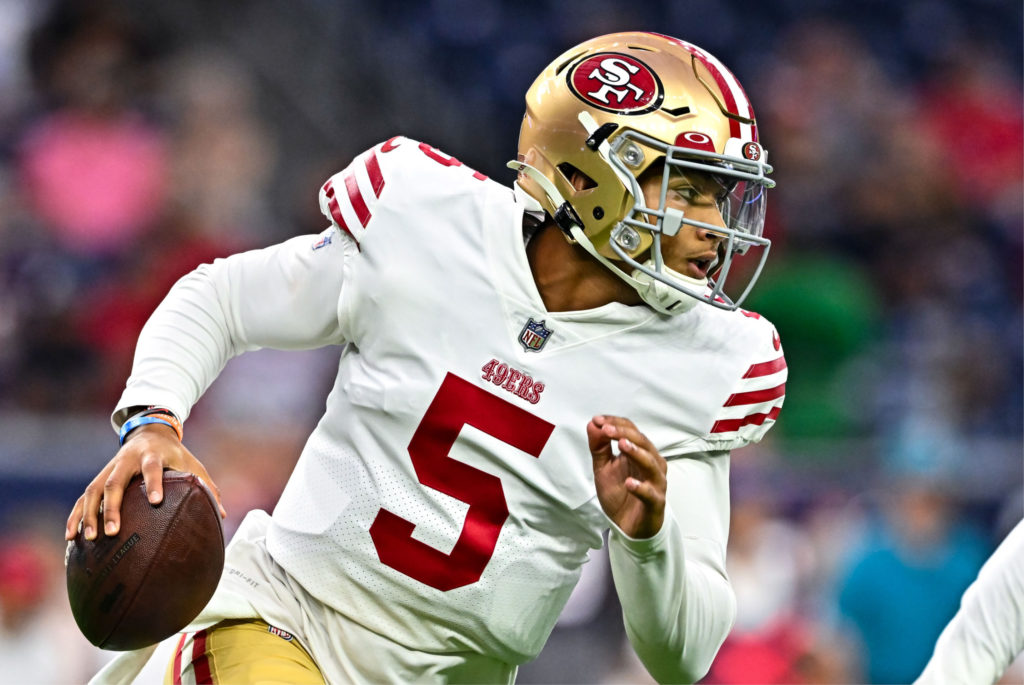
It was a GOOD Sunday in Week 2 as we saw a Jets win AND a Giants win (and an Eagles win for our Marlton and West Deptford peeps!). While the NFL injury report was thankfully quiet for most, we did see a significant change in the San Francisco lineup when quarterback, Trey Lance, sustained a season ending ankle fracture.
Westfield Clinic Director, Michael Gaeta, PT, DPT, CSCS, is very familiar with Trey’s injury as he had sustained a similar one in high school. In fact, it was this injury and his following rehab that inspired Mike to become a physical therapist. This week he is giving us some insight into “what” and “how” of an ankle fracture and subsequent rehabilitation.
Trey Lance was reported to have fractured his ankle. Can you explain a little bit about the anatomy of the ankle? How does an ankle fracture like Trey’s occur?
Lance fractured his right fibula and experienced ligament disruption or tearing. The fibula is one of two bones of the shin and is the lateral bone in the lower leg. Ligaments attached bone to bone and stabilize the joint. Looking at the video of Lance’s injury, it looks like the ligaments that may have been injured are the deltoid and anterior inferior tibiofibular ligaments.
This type of injury can be caused by “low energy” or “high energy”. In a low energy mechanism, the ankle is usually rolled or twisted when the foot is planted. A high energy mechanism of injury is a forceful traumatic event. In Lance’s case, his foot was planted when he was forced into an awkward position, then landed on by an opposing player.
Dak Prescott sustained a similar significant ankle injury in the 2020 season. Can you compare the two?
Based on reports, Lance’s injury was not nearly as significant as Dak’s. Dak sustained a compound fracture and dislocation. A compound fracture will occur when the bone breaks the skin. Dak also fractured his tibia. There was speculation about whether Lance dislocated his ankle as well. In a dislocation, the bones of the ankle displace, and the ligaments are torn. It’s not uncommon for a fibular fracture and ankle dislocation to happen at the same time.
What is the surgery like for this kind of injury? What is the rehab like for this kind of injury?
Lance’s surgery set the bones and ligaments and ensuring they are in proper anatomical alignment. Plate and screws are inserted into the bone and disrupted ligaments are repaired and augmented to provide stability. As the healing process begins, new bone growth will form around the plates and screws and the repaired ligament(s) with anchor into the bone.
Lance will be non-weightbearing, immobilized and likely placed in a hard cast for at least 6-8 weeks post op. If recovery is progressing well, then he will likely be able to transition to increased weight bearing capacity. His physical therapy will begin with restoring ankle range of motion while maintaining knee, hip, and core muscle strength, and eventually progressing into ankle strengthening. Hopefully, Lance will be able to begin light football specific activities at the 12-week mark, but it all depends on how his recovery progress.
What is unique about Trey Lance at the quarterback position is that he is a mobile QB. He will need to build up his ankle proprioceptive strength, balance, and agility so he is able to run, cut, land and plant on this right ankle with confidence. Another consideration is that he is right-handed. He will need to be able to plant and push off his right leg to throw passes. Being that the 49ers view Lance as their QB of the future, I believe they will take a conservative approach to his rehab program so that he is 100% by the beginning of the 2023 season.
**The medical information contained herein is provided as an information resource only, and does not substitute professional medical advice or consultation with healthcare professionals. This information is not intended to be patient education, does not create any patient-provider relationship, and should not be used as a substitute for professional diagnosis, treatment or medical advice. Please consult with your healthcare provider before making any healthcare decisions or for guidance about a specific medical condition. If you think you have a medical emergency, call your doctor or 911 immediately. IvyRehab Network, Inc. disclaims any and all responsibility, and shall have no liability, for any damages, loss, injury or liability whatsoever suffered as a result of your reliance on the information contained herein.
